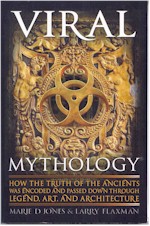 |
|
|
| ||||||
|
|
This page is the original source of this review, though you may also find it on Amazon or other sites. | ||
| Book Reviews Home | Free Audio Books | |
 |
Book Review of: Viral MythologyHow the Truth of the Ancients was Encoded and Passed Down through Legend, Art, and Architecture Price: $12.48 Availability: Usually ships within 24 hours |
| Review of
Viral Mythology, by Author (Softcover, 2014) (You can print this review in landscape mode, if you want a hardcopy) Reviewer: Mark Lamendola, author of over 6,000 articles. This is an interesting and informative exploration into how myths have managed to spread among cultures past and present. The book delivers on the promises made in both the title and the subtitle. To me, that's important. It's also unusual, today. It seems like someone who doesn't bother reading the book typically writes the subtitle, but in the case of Viral Mythology the subtitle nicely sums up what you're going to read. That said, the authors don't pretend to know exactly how this or that myth was propagated. But they do explore the possibilities, and that is what makes this book so interesting. This examination may also help readers understand how many myths of today get propagated. In this era of spin, propaganda, brainwashing, and lies spewed forth as truth, there may even be some lessons that will help the reader discern truth from fiction. The authors practiced their craft well and/or had an excellent copy editor. The text is in Standard Written English, a rarity. If Congress passed a law mandating English as our official language, most American authors would instantly become criminals. In addition to getting the mechanics right, the authors simply wrote well. The book has an almost vibrant style to it, somewhat tempered by an academic flavor. Maybe practice really does make perfect. The authors have produced several bestsellers. It would not surprise me if Viral Mythology joined the list that already includes such notable works as This Book is from the Future and The Trinity Secret. The authors ask how ancient cultures were able to widely spread (go viral with) information that was important to them, because they obviously did not have our electronic means of disseminating information. The answer is they embedded the information in other things, such as legend, art, and architecture (there's that subtitle again!). You can embed information into all sorts of things. One way very common to the ancients, and to people of today, is via storytelling. The story is captivating fiction and thus memorable, but in the story are the facts, ideas, perceptions, principles, or concepts that need to be spread or passed down. This is, despite believers' views to the contrary, the basis for stories of their religion. The authors touch on this rather delicate point in a manner that shows fairness and intellectual integrity. The stories of cultures that are widely separated by time and/or geography have striking similarities. The tell remarkably similar stories, often using the same symbology. Why is this? That's a question the authors deftly explore. Many authors, such as the famous Erich von Daniken, have concluded the explanation must point to help from aliens from another planet. The authors posit this possibility, among others, letting the reader puzzle over what the actual answer might be. Since we can't really know, and the authors are adamant we cannot really know, this approach maintains intellectual integrity. Many legends and fairy tales from ages ago have long been dismissed and merely baseless fiction. But with new knowledge gained over the past few decades, we are seeing that "there's something to it" in those legends and fairy tales. The information was embedded in ways that have made it difficult for us to pull it out of the background noise, but there's real information to be found. Cultural clues that make sense to people in one era have no resonance at all with people from another era or culture. If we can examine the stories in the context of the culture in which they were told, they can hold startling revelations. An interesting twist on all this examination of myths and legends is the authors compare the key elements to those of modern myths and legends, and older methods of communication to modern methods of communication. You do see patterns emerge. To me, the ability to see these patterns helps the reader see the patterns of deliberate disinformation as well. A great example of how this is done in film is the movie V for Vendetta. Other readers may see a different benefit of this comparison, such as how suppressed information can be coded and passed along; the authors give some examples of this. The main text consists of eight chapters spanning 229 pages. The first Chapter is titled "Information Please: How We Spread It, How We Get It," and that title gives you a glimpse of the kinds of issues the authors look at. The book also has three longish elements preceding the text: a Foreword, Prologue, and Introduction. The text is followed by a chapter-length piece titled "Conclusion." At four pages long, the bibliography seems a tad on the light side. But the sources themselves are pretty heavy. Many authors today bloat out their bibliography with Wikipedia entries rather than primary or secondary source material. Some do even worse and use known sources of fiction and misrepresentation, such as the New York Times (whose fact checkers are apparently good at weeding out facts). Again, there's that intellectual integrity thing that these authors seem dedicated to maintaining. Overall, a good read. It might not be life-changing for you, but if you clearly see the communication patterns it reveals and apply those to the myths of today, it very well could be. | |
| |||||